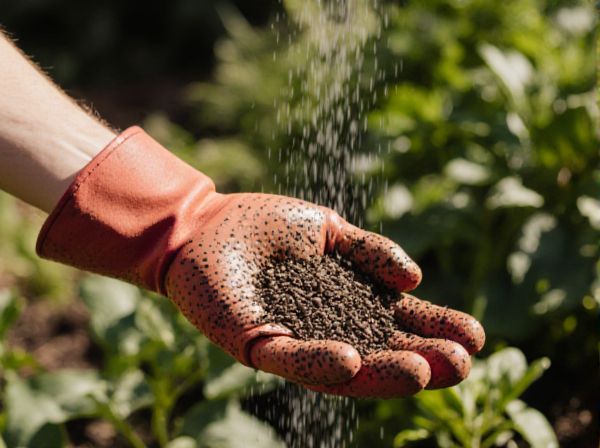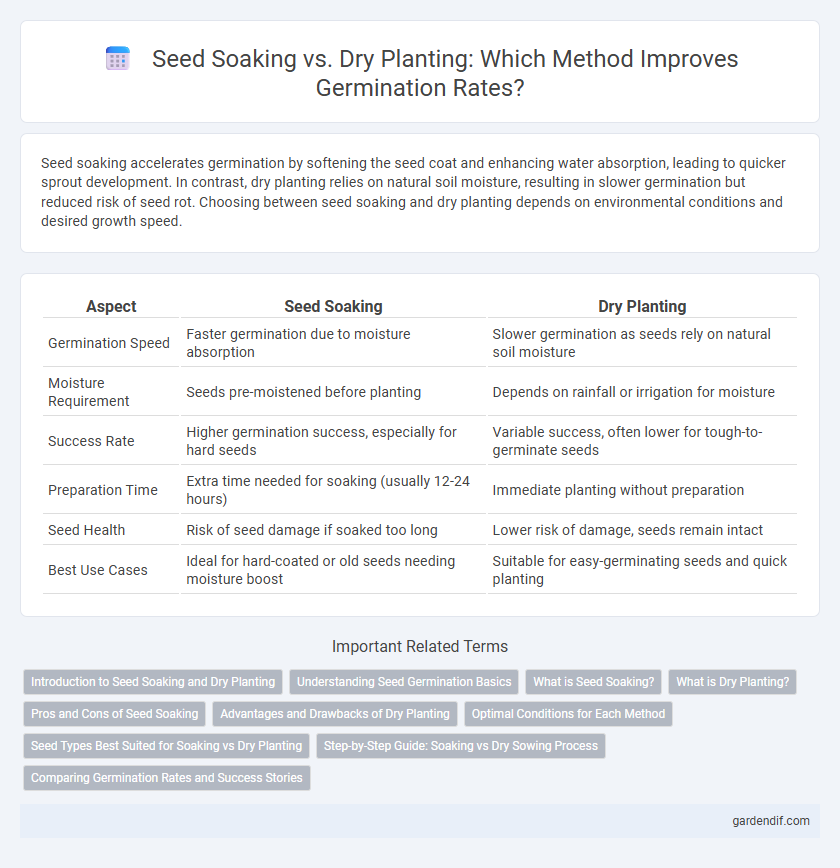
Seed soaking vs Dry planting Illustration
Seed soaking accelerates germination by softening the seed coat and enhancing water absorption, leading to quicker sprout development. In contrast, dry planting relies on natural soil moisture, resulting in slower germination but reduced risk of seed rot. Choosing between seed soaking and dry planting depends on environmental conditions and desired growth speed.
Table of Comparison
| Aspect | Seed Soaking | Dry Planting |
|---|---|---|
| Germination Speed | Faster germination due to moisture absorption | Slower germination as seeds rely on natural soil moisture |
| Moisture Requirement | Seeds pre-moistened before planting | Depends on rainfall or irrigation for moisture |
| Success Rate | Higher germination success, especially for hard seeds | Variable success, often lower for tough-to-germinate seeds |
| Preparation Time | Extra time needed for soaking (usually 12-24 hours) | Immediate planting without preparation |
| Seed Health | Risk of seed damage if soaked too long | Lower risk of damage, seeds remain intact |
| Best Use Cases | Ideal for hard-coated or old seeds needing moisture boost | Suitable for easy-germinating seeds and quick planting |
Introduction to Seed Soaking and Dry Planting
Seed soaking involves immersing seeds in water to accelerate the germination process by softening the seed coat and promoting enzymatic activity. Dry planting places untreated seeds directly into the soil, relying on natural moisture and temperature conditions for germination. Both methods impact germination speed and seedling vigor, with seed soaking often leading to faster and more uniform sprout development.
Understanding Seed Germination Basics
Seed soaking enhances germination by softening the seed coat and accelerating water absorption, which triggers metabolic processes essential for sprouting. In contrast, dry planting relies on natural soil moisture levels, often resulting in slower or less uniform germination rates, especially in arid conditions. Understanding these differences helps optimize germination success by selecting the appropriate method based on seed type and environmental factors.
What is Seed Soaking?
Seed soaking involves immersing seeds in water for a specific period, typically 12 to 24 hours, to accelerate germination by softening the seed coat and activating metabolic processes. This technique enhances water absorption, leading to faster and more uniform sprouting compared to dry planting, where seeds are sown directly into soil without pre-treatment. Seed soaking is particularly effective for hard-coated or dormant seeds that require moisture to break dormancy and initiate growth.
What is Dry Planting?
Dry planting refers to sowing seeds directly into the soil without pre-soaking or priming them, relying on natural moisture for germination. This method is especially suited for hardy seeds with tough coats that require gradual hydration, allowing them to develop stronger roots. Dry planting minimizes the risk of seed rot and is commonly used in large-scale agriculture for crops like wheat and barley.
Pros and Cons of Seed Soaking
Seed soaking accelerates the germination process by softening the seed coat and allowing water to penetrate quickly, which can lead to faster sprouting and more uniform seedling emergence. However, prolonged soaking may cause seed rot or fungal growth, reducing overall seed viability. Dry planting avoids these risks but often results in slower germination rates and inconsistent seedling development due to delayed water uptake.
Advantages and Drawbacks of Dry Planting
Dry planting allows seeds to be sown directly into soil without pre-soaking, reducing labor and water use while minimizing the risk of seed rot. However, dry planting can result in slower germination rates and inconsistent moisture availability, which may lead to uneven seedling emergence. This method is best suited for seeds with hard coats or those adapted to natural soil moisture fluctuations but may require careful soil preparation to optimize conditions.
Optimal Conditions for Each Method
Seed soaking accelerates germination by hydrating seeds in water for 12 to 24 hours, creating ideal moisture and temperature conditions around 20 to 25degC that activate enzymatic processes. Dry planting relies on soil moisture, requiring consistent irrigation and temperatures between 18 to 22degC to ensure gradual water absorption and steady seedling emergence. Optimal seed soaking suits fast germination in controlled environments, while dry planting excels in well-prepared, naturally moist soil where gradual hydration supports root development.
Seed Types Best Suited for Soaking vs Dry Planting
Seeds with hard coats, such as beans, peas, and squash, benefit from soaking to accelerate germination by softening their outer layer. Conversely, small or fine seeds like lettuce, carrots, and onions are best suited for dry planting to prevent rot and ensure proper air circulation. Understanding seed type characteristics determines whether soaking enhances germination success or dry planting preserves seed viability.
Step-by-Step Guide: Soaking vs Dry Sowing Process
Soaking seeds before planting accelerates germination by hydrating the seed coat, typically requiring 8-24 hours in lukewarm water to soften and break dormancy. In contrast, dry sowing involves directly placing seeds into soil without pre-treatment, relying on natural moisture and temperature to trigger sprouting over a longer period. Properly soaked seeds often yield faster and more uniform germination rates compared to dry sowing, where variability in soil conditions can affect emergence consistency.
Comparing Germination Rates and Success Stories
Seed soaking accelerates water absorption, leading to faster and higher germination rates compared to dry planting, which relies solely on natural soil moisture. Studies show soaked seeds can achieve germination success rates up to 90%, while dry planting often results in slower and less uniform sprouting, especially in hard-coated seeds. Success stories from farmers using seed soaking techniques report improved crop yields and more consistent plant development, highlighting its effectiveness over traditional dry sowing methods.
Seed soaking vs Dry planting Infographic

 gardendif.com
gardendif.com